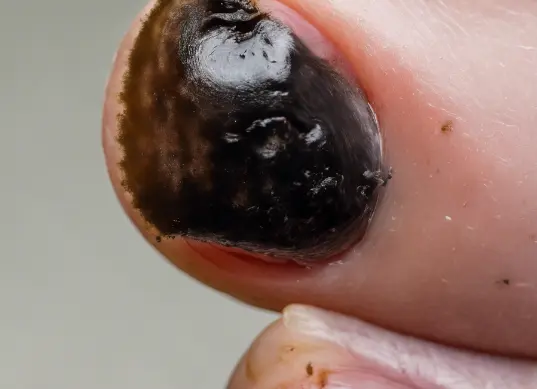Discovering black mold under a toenail can be a cause for concern. This unsightly condition can be uncomfortable and even painful, but most importantly, it warrants prompt attention and treatment.
We will investigate the reasons behind the development of black mold beneath a toenail and explore various effective measures that can be taken to resolve this problem.
Causes of Black Mold Under the Toenail
A fungal infection called onychomycosis is a common cause of black mold under a toenail. This infection is a result of fungi invading the nail bed and causing the growth of mold or fungi underneath the toenail. There are several factors that can lead to the development of black mold, such as:
- Poor Hygiene: Insufficient foot hygiene, such as wearing dirty or damp socks and shoes, can create a favorable environment for the growth of fungi.
- Trauma: Injuries to the toenail can damage the nail bed, allowing fungi to penetrate and thrive, resulting in black mold growth.
- Wearing Tight Shoes: Shoes that are too tight or ill-fitting can cause excessive sweating, which can lead to increased moisture and create conditions suitable for fungal growth.
- Warm and Humid Environments: Warm and humid conditions, such as public showers and swimming pools, provide an ideal breeding ground for fungi.
What to Do When You Discover Black Mold Under a Toenail
- Consult a Healthcare Professional: It is crucial to seek guidance from a healthcare expert like a podiatrist or dermatologist if you have concerns about potential black mold beneath your toenail. These professionals have the expertise to correctly diagnose the problem and may even collect a sample of the affected nail for fungus analysis.
- Follow Treatment Recommendations: Your healthcare provider will suggest the most suitable treatment plan based on the seriousness and scope of the infection. This could involve using antifungal creams or taking oral medications, or a combination of both. It is important to faithfully adhere to the prescribed treatment in order to effectively eliminate the black mold.
- Practice Good Foot Hygiene: In order to prevent black mold from coming back or spreading, it is important to practice good foot hygiene. This entails regularly washing and drying your feet, changing socks frequently, and wearing shoes that allow your feet to breathe. It is also advisable to avoid sharing towels, socks, or shoes with others to decrease the chances of getting infected.
- Wear Proper Footwear: Opt for shoes that fit well and provide adequate ventilation. Choose moisture-wicking socks that help keep your feet dry and minimize moisture accumulation.
- Keep Nails Trimmed: Regularly trimming your toenails and keeping them short can help prevent fungal infections by reducing the risk of injury.
Conclusion
While it may cause concern to discover black mold under a toenail, it is crucial to promptly take action and seek help from professionals to properly treat it and avoid further complications. Follow the recommended treatment plan, practice good foot hygiene, and wear appropriate shoes to reduce the likelihood of experiencing recurring fungal infections. Always remember that consulting a healthcare professional is vital for an accurate diagnosis and treatment of black mold under a toenail.

